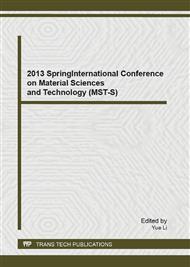p.246
p.252
p.258
p.264
p.270
p.275
p.281
p.289
p.294
Preparation of Poly(Vinylbenzyl Chloride)@Lead Sulfide (PVBC@PbS) Core-Shell Nanospheres and Adsorption of Phenol
Abstract:
We have demonstrated the fabrication of novel poly(vinylbenzyl chloride)@lead sulfide (PVBC@PbS) core-shell nanospheres via the atom transfer reversible polymerization (ATRP) of lead dimethacrylate (Pb(MA)2) initiated from methyl chloride groups on surfaces of PVBC nanoparticles and subsequent reaction with ethanethioamide. The chemical structure of the PVBC@PbS nanospheres was confirmed by the fourier transform infrared (FTIR) spectroscopy, and the morphology of the nanospheres were investigated by scanning electron microscopy (SEM) and transmission electron microscopy (TEM). The average size of the nanospheres was determined to be about 100 nm. The PVBC@PbS nanospheres were able to absorb phenol in the solution, and the balanced adsorption capability of phenol to nanospheres could reach to 7.2 μg/mg.
Info:
Periodical:
Pages:
270-274
Citation:
Online since:
June 2013
Authors:
Keywords:
Price:
Сopyright:
© 2013 Trans Tech Publications Ltd. All Rights Reserved
Share:
Citation:


